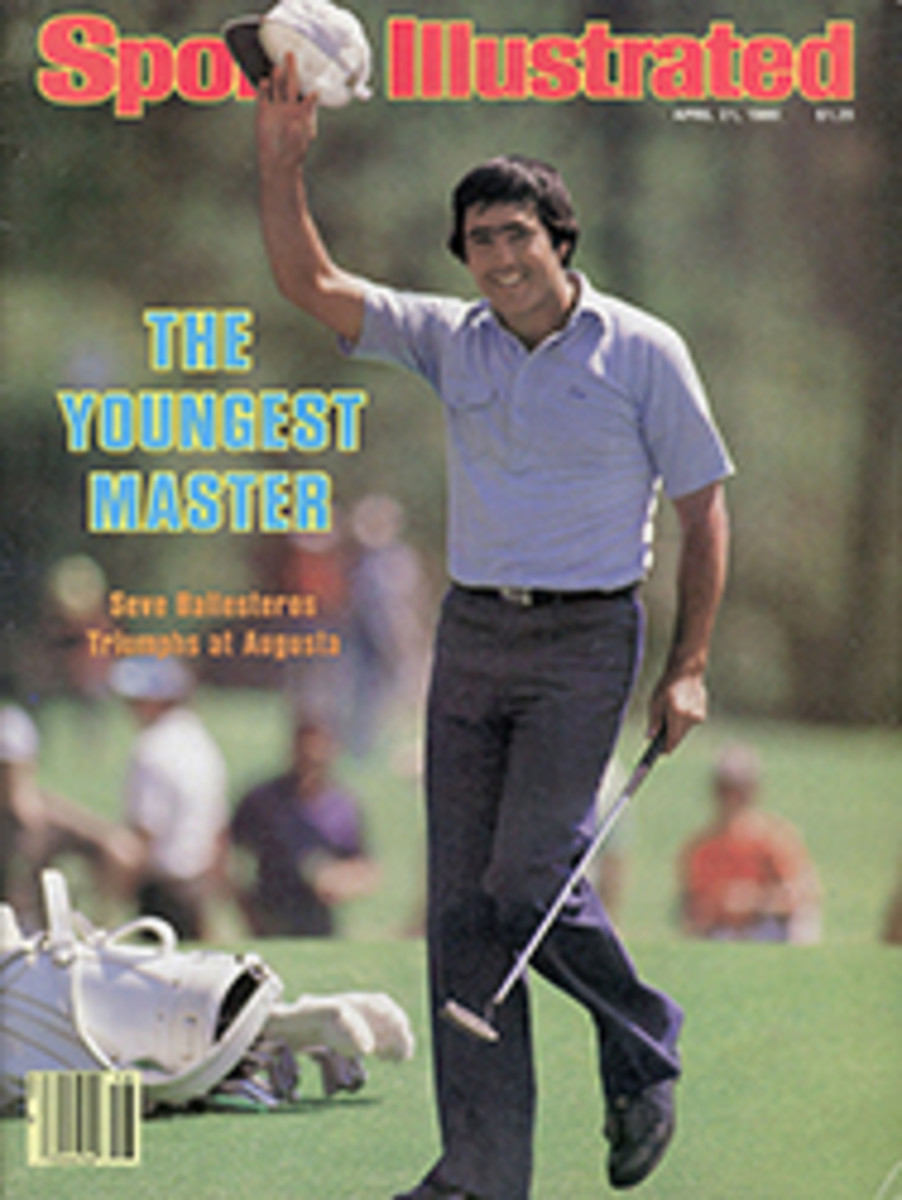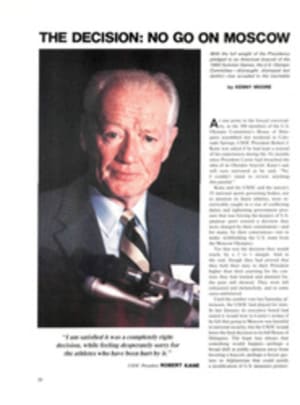
Too bold to cut the mustard?
I'm not perfect," Marshall Holman says, "but I'm as close as anybody can get." Right you are, Marshall Holman. You're a perfect boor. A perfect twerp. A perfect pest. A perfect pain in the you-know-what. Yes, Marshall, you are the perfect hot dog, and there's not enough Gulden's in all those dirty yellow squirt tubes at the concessions counters on the Pro Bowlers tour to cover your act.
Holman is the bowler that people everywhere love to hate. When he makes a big shot in a match, he stomps his feet, punches the air, leaps, spins around and lets out the sort of snarl that drill sergeants emit during bayonet training. Boo. When an opponent makes a big shot, Holman sticks his fingers in his ears to drown out the crowd's cheers. Boo. Holman also enjoys stirring up fans by bending over and presenting his posterior. Boo.
On the whole, the 25-year-old Holman qualifies as a summa cum laude graduate of the Nastase-Connors-McEnroe school of childish behavior, though, it must be conceded, there seems to be method to his madness. Indeed, not only is he a certified hot dog, heavy on the mustard, but he is also the hottest young hotshot ever to perform regularly on the pro bowling tour. Holman has won 11 PBA titles and more than $350,000 in his seven seasons, and in 1979 he averaged 217 pins per game—third behind Mark Roth's record 221 and Earl Anthony's 219—as he became the third and youngest bowler in PBA history to earn more than $100,000 in one year.
Holman joined the $100,000 club by throwing seven strikes in his first eight frames en route to a victory that was worth $21,000 in the last stop on the schedule, the Brunswick Memorial World Open at Deerfield, Ill. He also won the World Open in 1977, when he somehow rolled a 277 the last day after having spent most of the previous night playing cards. In 1976 Holman won bowling's premier event, the Firestone Tournament of Champions, and this week in Akron he will try to take the T of C again.
"Marshall's only trouble is that he simply can't cope with defeat and can't lose gracefully," says PBA Tournament Director Harry Golden. "He needs humility. But Marshall's trouble is not all his fault. Many fans come just to watch Marshall and to get on him. I've had to quiet down crowds because they sent up such crescendos when Holman was on the lanes that it disturbed other bowlers."
What may have triggered Holman's hate affair with the fans was a 1976 T of C match against Dick Weber, who is the antithesis of Holman: a perfect gentleman, a humble winner, a gracious loser. The score was close until Holman was left with a nasty split in the 10th frame. While Holman pouted, the crowd cheered his misfortune. Some spectators carried on at such length and with such venom that Weber felt compelled to tell them to knock it off. They did—temporarily. Ever since, it has been fashionable to dump on Holman, who, of course, has never hesitated to return the favor.
Holman has been involved in other flare-ups, including a 1979 incident at a tournament in Seattle that got him on probation for a year. Hall of Fame Bowler Dave Davis, the TV color commentator at that event, recalls, "Jeff Mattingly needed three strikes in the 10th to beat Holman 258-257 and take the lead into the next day's finals. After Jeff got a strike on his first ball, Marshall kicked a chair and sent it banging around. After the second strike, Marshall kicked the ball rack right next to Jeff. After the third strike, Holman went crazy, throwing pencils and being obnoxious. It was disgusting. On the lanes Marshall can be a jerk. Off the lanes he's marvelous."
Holman is hardly at a loss to explain his misbehavior. "To me, the bowling center is my office," he says. "When things aren't going well for me at the lanes, I let loose. I don't think it's healthy to take your troubles back to your room or your family. I just wish everyone could sit down and have a meal with me. They'd find I'm a decent guy. When I leave the lanes, I leave my game there."
Maybe so, but if Holman persists in letting loose on the lanes during his probation, he could be suspended indefinitely from the tour. "I'm being forced to make changes," Holman says. "I'll always be me, but now I have to think about what I can or cannot do. If I calm down like the average pro, I'd probably calm my earnings way down. Sure, a lot of people root against me. A group in Chicago wrote that they were disgusted with me, slapped me in the face for being Jewish and wished that I'd get cancer. But there are also plenty of people who enjoy what I do. I've done more to help pro bowling than any other bowler. Already I see other young bowlers on the tour imitating me—and getting away with it."
To Holman, it is imperative that the PBA change its bland and boring image. What bowling needs, he believes, is someone with flair. Someone like, well, Marshall Holman.
Holman has his supporters, too, including Anthony and Roth, each of whom won three Bowler of the Year awards in the past six seasons, and Hall of Famer Carmen Salvino. "We need bowlers who will attract the public," says Anthony, one of the most tranquil of all bowlers. "Right now Marshall is taking a lot of heat, but the day will come when he'll polish his act, and he'll go from arrogance to colorfulness."
Or as Holman says, "If I were 30, people might say I was just confident."
"Let Marshall do his thing," Roth pleads. "That's how he gets pumped up. I think he's great. But there are guys on the tour who hate his guts." Unfortunately, most bowlers who harbor such feelings refuse to speak up, even off the record, preferring not to rile Holman, who performs best when he feels put upon.
"Holman is our Nastase," Salvino says. "Athletes can be colorful in various ways. Some bring out warmth, some bring out laughs. Some, like Holman, bring out the hostility in fans. That's not all bad. People want to love and people want to hate. That's human nature. Sadly, the PBA doesn't encourage individualism among its bowlers. That's why Holman stands out. It's nice to have somebody like him on the tour, somebody who's not a robot."
To Holman's way of thinking, holding back one's emotions or opinions is a form of dishonesty. So he doesn't.
"In a restaurant, if Marshall's eggs are not just the way he likes them, he'll tell the waitress, 'I won't eat this crap,' " says Roy Buckley, one of Holman's friends on the tour. "It embarrasses me to be around him when he's that bold. But if his eggs are done right, he'll tell the waitress, 'They were perfect. Great job.' That's the way Marshall is. He can be very understanding about many things. So polite. He can also be offensive and impolite. I like Marshall. It's just that he's like a mustang: he has to be broken."
"I suppose I do ham it up at times," Holman admits. "I probably got that from my father. He was a disc jockey for KFHA in Medford, Oregon, where I grew up. In 1952 my dad became a broadcaster-flagpole sitter. He was known as 'Holman the Poleman.' "
"Yes, I think Marshall does some of my bits," says Phil Holman, who is called the Bald Ego by his son. "He's a lulu. What he does is showmanship. Marshall represents the young people of today and their philosophy of saying what they think. He's flashy and sophisticated, and he speaks well. Sure, he comes off like a smart aleck, and he's cocky and he glares, and some people don't like his Elvis Presley moves. But when he was in high school, I called him 'America's leading underachiever.' He was smart, but he didn't apply himself. And he was so quiet. I don't know what brought about the transformation."
Marshall may have been quiet around home, but he was explosive on the lanes even as a teen-ager. Andy Anderson, the proprietor of the lanes where Holman honed his game, says, "The city fathers of bowling called him down several times. They didn't like him kicking the ball rack and making obscene gestures."
Nobody booed Holman in 1971 when he had a brief fling on the tour. Some looked askance at the long hair he wore then, but he simply couldn't bowl well enough to attract all that much attention. Only 17, Holman was too awed by the big-name pros he had idolized and too confused by the grind of circuit life to bowl as well as he had in Medford.
So Holman went home, having won only $500. After bowling a couple of years in the Northwest, he returned to the tour in 1974. "Back then I practiced every day, 20 games at least," Holman says. "My dedication made me a good bowler. Now I'm lazy. I rarely stay on the tour for more than three, four weeks at a time before I go home for a rest."
Some people would prefer that Holman stay permanently with his wife, Barbara, at their place outside of Medford. But others, like Salvino, believe Holman belongs on the tour. "I've encouraged Marshall," Salvino says, "but I've also told him, 'You have to avoid being vulgar.' All he needs is maturity, and that will come. If there were 20 Holmans on the tour, there wouldn't be enough room for the crowds."
Holman's bowling style is, like his behavior, explosive. He may be small at 5'9" and 140 pounds, but he rolls heavy. While preparing to bowl, Holman stands with his heels off the end of the approach. Then he darts madly across the 15 feet to the head of the lane—knees bent, body crouched low, feet scurrying—arcing the 16-pound ball through the backswing and, finally, whipping it violently forward. Holman bowls with so much power that his right arm sometimes cracks across his forehead and mustache as he executes his exaggerated follow-through.
"I'm fortunate," he says. "My game blends well with today's lane conditions, which favor hard-throwing crankers."
As for his behavior, there have been indications in recent months that Holman may be undergoing a change of image. "Marshall has been congratulating guys who've beaten him," says Golden. "He even hugged one guy."
Holman, however, rejects the possibility of a personality transplant. "Nobody is ever going to change me," he says. "Nobody." Hooray! Boo.
THREE PHOTOS

